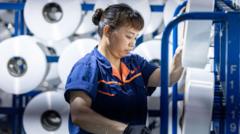China's Economic Growth Slows Amid Trade Turmoil and Property Crisis
China's economic expansion faces challenges as trade tensions and a housing market crisis impact growth rates.
China's economy has shown signs of slowing down, growing by 5.2% in the second quarter of the year as trade tensions from U.S. tariffs and a prolonged property market crisis weigh heavily on growth. This latest figure marks a decrease from the previous quarter's 5.4% growth. Despite the economic pressures, there are indications that the country has avoided a significant downturn, aided by government interventions and a fragile truce with the U.S. National Bureau of Statistics highlighted that manufacturing enjoyed a robust 6.4% increase, driven by higher demand in sectors such as 3D printing, electric vehicles, and industrial robots. However, the services sector and retail sales are showing signs of strain, with retail growth decelerating to 4.8% in June compared to 6.4% in May. New home prices also fell, with the real estate sector continuing to face difficulties, prompting concerns that China might not meet its annual growth target of around 5%. Economic analysts are cautious, indicating a likely floor of 4%, which is deemed the minimum acceptable growth politically. Trade relations remain tense with ongoing negotiations aimed at a long-term solution to the tariff issues affecting both nations.
China's economic expansion faces challenges as trade tensions and a housing market crisis impact growth rates.
China's economy has shown signs of slowing down, growing by 5.2% in the second quarter of the year as trade tensions from U.S. tariffs and a prolonged property market crisis weigh heavily on growth. This latest figure marks a decrease from the previous quarter's 5.4% growth. Despite the economic pressures, there are indications that the country has avoided a significant downturn, aided by government interventions and a fragile truce with the U.S. National Bureau of Statistics highlighted that manufacturing enjoyed a robust 6.4% increase, driven by higher demand in sectors such as 3D printing, electric vehicles, and industrial robots. However, the services sector and retail sales are showing signs of strain, with retail growth decelerating to 4.8% in June compared to 6.4% in May. New home prices also fell, with the real estate sector continuing to face difficulties, prompting concerns that China might not meet its annual growth target of around 5%. Economic analysts are cautious, indicating a likely floor of 4%, which is deemed the minimum acceptable growth politically. Trade relations remain tense with ongoing negotiations aimed at a long-term solution to the tariff issues affecting both nations.





















